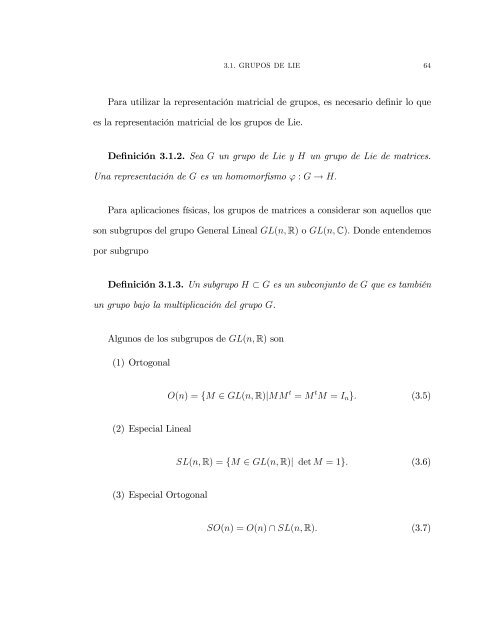INSTITUTO POLITÃCNICO NACIONAL - Instituto Avanzado de ...
INSTITUTO POLITÃCNICO NACIONAL - Instituto Avanzado de ...
INSTITUTO POLITÃCNICO NACIONAL - Instituto Avanzado de ...
You also want an ePaper? Increase the reach of your titles
YUMPU automatically turns print PDFs into web optimized ePapers that Google loves.
3.1. GRUPOS DE LIE 64Para utilizar la representación matricial <strong>de</strong> grupos, es necesario <strong>de</strong>…nir lo quees la representación matricial <strong>de</strong> los grupos <strong>de</strong> Lie.De…nición 3.1.2. Sea G un grupo <strong>de</strong> Lie y H un grupo <strong>de</strong> Lie <strong>de</strong> matrices.Una representación <strong>de</strong> G es un homomor…smo ' : G ! H:Para aplicaciones físicas, los grupos <strong>de</strong> matrices a consi<strong>de</strong>rar son aquellos queson subgrupos <strong>de</strong>l grupo General Lineal GL(n; R) o GL(n; C): Don<strong>de</strong> enten<strong>de</strong>mospor subgrupoDe…nición 3.1.3. Un subgrupo H G es un subconjunto <strong>de</strong> G que es tambiénun grupo bajo la multiplicación <strong>de</strong>l grupo G.Algunos <strong>de</strong> los subgrupos <strong>de</strong> GL(n; R) son(1) OrtogonalO(n) = fM 2 GL(n; R)jMM t = M t M = I n g: (3.5)(2) Especial LinealSL(n; R) = fM 2 GL(n; R)j <strong>de</strong>t M = 1g: (3.6)(3) Especial OrtogonalSO(n) = O(n) \ SL(n; R): (3.7)
















